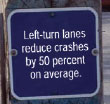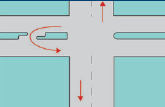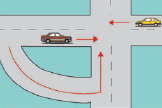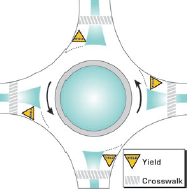- Purpose of the Brochure
- What is Access Management
- Access Spacing
- Turning Lanes
- Median Treatments
- Related Techniques
- Citations
- PDF Version

Benefits of Access Management
TURNING LANES
LEFT TURNS
Exclusive turning lanes for vehicles remove stopped vehicles from through traffic. Left-turn lanes at intersections substantially reduce rear-end crashes. A major synthesis of research on left-turn lanes demonstrated that exclusive turn lanes reduce crashes between 18 to 77 percent (50 percent average) and reduce rear-end collisions between 60 and 88 percent. [4]
Left-turn lanes also substantially increase the capacity of many roadways. A shared left-turn and through lane has about 40 to 60 percent the capacity of a standard through lane. [4]. A synthesis of research on this topic found a 25 percent increase in capacity, on average, for roadways that added a left-turn lane. [13]

INDIRECT TURNS
Some of the biggest issues with managing access come at intersections where vehicles must cross traffic. Some states and cities have adopted indirect turns to reduce these conflicts. In New Jersey, the jug-handle left turn requires a right turn onto a feeder street, followed by a left onto a cross street. Detroit has extensively used an indirect U-turn that requires a U-turn past an intersection, followed by a right turn instead of a regular left turn.
Like dedicated left-turn lanes, indirect turns reduce crashes, improve congestion, and add capacity. Crashes decline by 20 percent on average, and 35 percent if the indirect turn intersection is signalized. Capacity typically shows a 15 to 20 percent gain. [4]
 Indirect U-Turn |
 Jug Handle Jug Handle |
RIGHT TURNS
Right-turn lanes typically have a less substantial impact on crashes and roadway capacity than other types of turn strategies, because there are fewer limitations on right turns. Though there are fewer studies of these impacts, there is a clear relationship between the number of vehicles attempting a right turn in a through traffic lane and its delay to through traffic. This relationship is exponential - each additional car that must wait for a right turn will increase the delay more than the previous car. At intersections with substantial right-turn movements, a dedicated right-turn lane segregates these cars from through traffic and increases the capacity of the road.
| Right-Turning Vehicles Per Hour | Through Vehicles |
|---|---|
Under 30 |
2.4 |
| 31 to 61 | 7.5 |
| 61 to 90 | 12.2 |
| 90 and up | 21.8 |
ROUNDABOUTS
Roundabouts represent a potential solution for intersections with many conflict points. Though not appropriate for all situations, roundabouts reduce vehicle movements across traffic. Only a few studies have examined the safety benefits of roundabouts. One study of four intersections that were replaced with roundabouts in Maryland found a drop in crashes between 18 and 29 percent and a reduction in injury crashes between 63 and 88 percent. The cost of crashes at these locations - one measure of severity - was also reduced by 68 percent. Overall crashes on roundabouts were more minor than those at left turn locations. [9]
Another study of roundabouts
in several locations found a 51 percent reduction in crashes,
including a 73 percent reduction in injury crashes and a 32 percent
reduction in property-damage-only crashes for single-lane roundabouts.
Multi-lane roundabouts only experienced a 29 percent reduction
in crashes. [6]
 Roundabout |